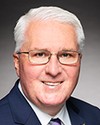Mr. Speaker, I want to ensure that members of the House have a full appreciation for what is at stake and how much Canadians were counting on the Liberal government to get this accessibility bill right. It is long overdue. It is true that the Conservatives should have done it in the 10 years they were in power, but Bill C-81 is so far from what our constituents and fellow Canadians need.
Terry Wiens, a man in my riding of Nanaimo—Ladysmith, was a victim of polio. He wrote to me, saying, “Remember that Paul Martin Sr. made a promise to polio victims in 1955 that they would never have to pay for the cost of health care that resulted from the federal government's failure for two years to introduce the polio vaccine.” That was a solemn commitment. He says, “Now that polio has been so successfully eradicated, the federal government has forgotten that polio should be part of health care.” This man who has worked all of his life. Now he finds that from the effects of polio, he has increasing disabilities. He has not been able to get the support he needs to get a specialized mattress and wheelchair. He pulled $10,000 out of his RRIF, his registered retirement income fund, to pay for these things.
He further described the cascade of impacts that happened from that. He said, “I didn't realize the ripple effects of that decision. It raised my annual income enough to eliminate me from the guaranteed income security, all $18 a month worth. I have no doubt that next year I'll qualify again, but in the meantime, we are penalized for our independence. To add insult to injury, losing that GIS also cost me my premium medical services subsidy, another $420 a year cost. My opportunity for subsidized assisted living, the GIS qualification is required for the payment and on it goes.”
Therefore, what in this legislation will fix things for Terry and the many other Canadians who were counting on the government to take their advice and get this bill right?








